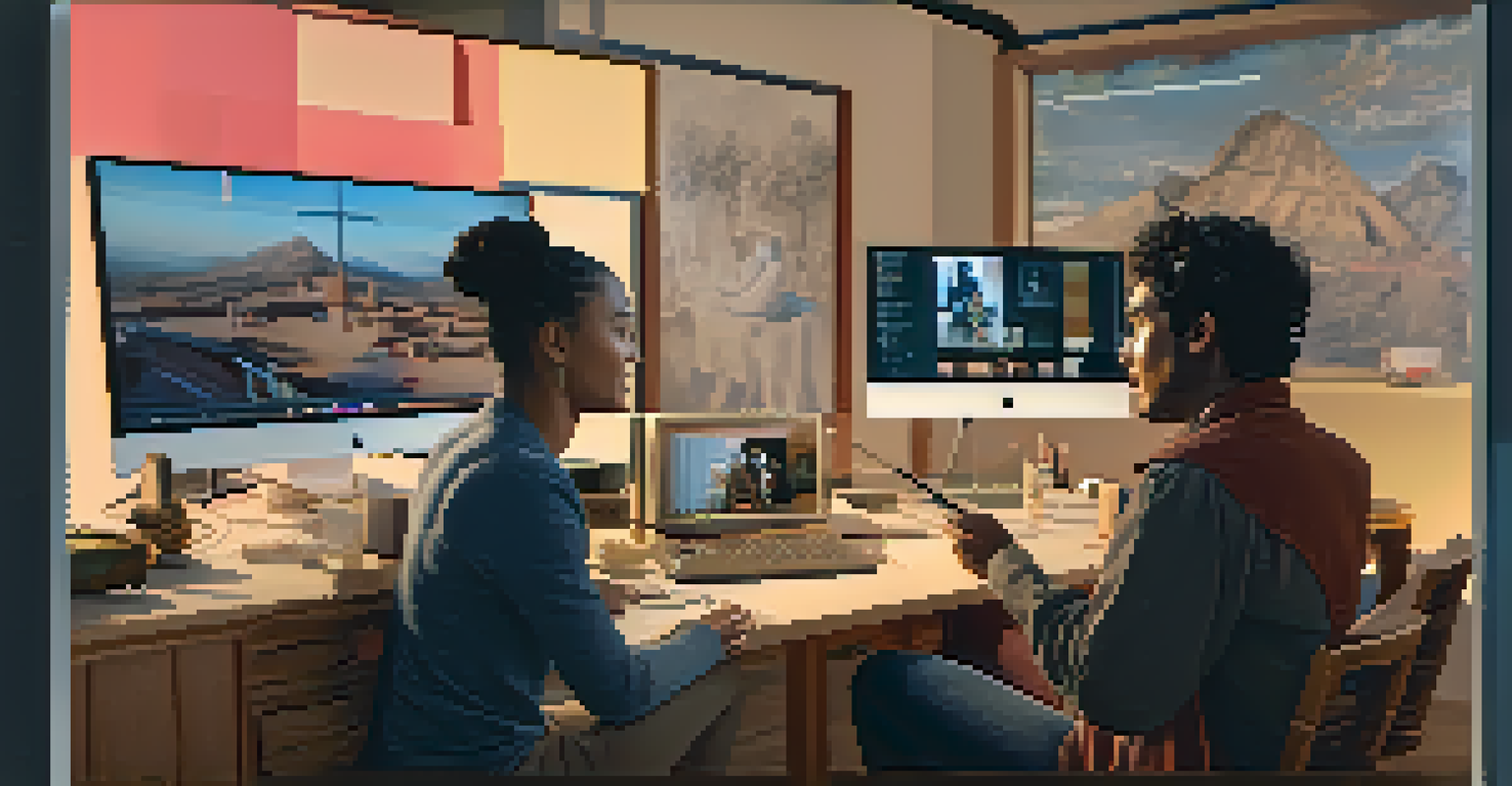Cinematic Collaboration: Hollywood and International Filmmakers

The Evolution of Global Cinema Collaborations
In recent years, the landscape of cinema has transformed dramatically, leading to fruitful collaborations between Hollywood and international filmmakers. The rise of digital media and streaming platforms has allowed for greater access to diverse stories and talent from around the globe. This evolution reflects a growing appreciation for cultural exchanges, where stories transcend borders and resonate with wider audiences.
Cinema is a matter of what's in the frame and what's out.
Take, for instance, the success of films like 'Parasite,' which not only won an Academy Award but also showcased the brilliance of South Korean cinema on a global stage. Such achievements demonstrate how international filmmakers can bring unique perspectives to Hollywood productions while also benefiting from the vast resources and distribution networks that Hollywood offers. This synergy is paving the way for a more inclusive cinematic landscape.
Moreover, as audiences become more sophisticated and demand richer narratives, Hollywood has recognized the need to collaborate with international filmmakers. This partnership not only enhances storytelling but also helps to elevate underrepresented voices in the industry, creating a more diverse and engaging cinematic experience.
Successful Collaborations: Case Studies
One of the most notable examples of successful collaboration is the partnership between director Guillermo del Toro and various international production teams. His films, such as 'The Shape of Water,' beautifully blend elements from multiple cultures, resulting in a unique cinematic experience that resonates worldwide. This fusion of styles is a testament to the power of collaboration across borders.

Another significant collaboration is the film 'Crouching Tiger, Hidden Dragon,' which brought together Chinese director Ang Lee and Hollywood production teams. This film not only achieved commercial success but also opened the doors for more Asian films in Western markets. It exemplifies how melding different cinematic traditions can lead to groundbreaking successes.
Global Collaborations Enhance Cinema
The rise of international collaborations in filmmaking enriches storytelling and allows diverse narratives to resonate with global audiences.
Additionally, the recent collaboration between Marvel Studios and international filmmakers, like Taika Waititi for 'Thor: Ragnarok,' showcases how diverse storytelling can enhance well-known franchises. By incorporating various cultural elements, these collaborations breathe new life into established narratives, making them more relatable to global audiences.
Challenges in Cross-Cultural Filmmaking
While collaboration offers numerous benefits, it also comes with its fair share of challenges. Language barriers can create misunderstandings, making it crucial for filmmakers to prioritize clear communication throughout the process. This is where the role of skilled translators and cultural consultants becomes invaluable in bridging these gaps.
The beauty of cinema is that it can bridge cultures and connect people from all walks of life.
Moreover, differing cultural sensibilities can lead to friction in storytelling. What resonates in one culture may not translate well in another, and filmmakers must navigate these nuances carefully. For instance, humor can be highly subjective, and what is funny in one culture may not be perceived the same way in another, potentially alienating audiences.
Additionally, there are often logistical challenges when working across different countries, such as varying regulations and production practices. These hurdles require flexibility and adaptability from all parties involved, as they strive to create a cohesive vision while respecting the unique aspects of each culture.
The Role of Technology in Cinematic Collaboration
Technology plays a pivotal role in facilitating cinematic collaborations on a global scale. With advancements in video conferencing, filmmakers can easily communicate and share ideas regardless of their physical location. This connectivity has been a game-changer, especially during times when travel is restricted, allowing creative minds to collaborate seamlessly.
Moreover, digital platforms have made it easier for international films to reach wider audiences. Streaming services like Netflix and Amazon Prime have invested heavily in global content, providing a platform for diverse stories from various cultures to shine. This exposure not only benefits filmmakers but also enriches the viewing experience for audiences worldwide.
Technology Fuels Cinematic Unity
Advancements in technology, such as video conferencing and streaming platforms, have made it easier for filmmakers worldwide to collaborate and share their unique stories.
Additionally, innovative filmmaking technologies like virtual reality (VR) and augmented reality (AR) are opening new avenues for storytelling. These tools allow filmmakers to create immersive experiences that can engage audiences in ways traditional film cannot, further enhancing the collaborative potential of global cinema.
Impact of Globalization on Film Narratives
Globalization has significantly influenced film narratives, encouraging stories that reflect a blend of cultures. Today's audiences crave authenticity and diverse perspectives, pushing filmmakers to explore themes that resonate across borders. This shift has led to more inclusive storytelling that reflects the complexities of our interconnected world.
A prime example of this trend is the film 'The Farewell,' which navigates both Chinese and American cultural landscapes. The film's exploration of family dynamics, grief, and cultural identity resonates with audiences from various backgrounds, showcasing the power of universal themes. This ability to tell stories that speak to multiple cultures is a hallmark of successful cross-cultural collaborations.
As globalization continues to shape the film industry, filmmakers are increasingly encouraged to think beyond their own cultural contexts. This broader perspective not only enriches narratives but also fosters a deeper understanding of the diverse experiences that define our global society.
The Future of Hollywood and International Collaborations
Looking ahead, the future of collaborations between Hollywood and international filmmakers appears bright. As audiences become more engaged with global content, there is a growing demand for films that reflect diverse experiences. This trend is likely to encourage further partnerships, resulting in innovative storytelling that captivates viewers worldwide.
Furthermore, as streaming platforms continue to dominate the industry, the barriers that once hindered international collaborations are slowly dissolving. Filmmakers from different corners of the world can now easily connect and share their unique voices, leading to a richer cinematic landscape. This democratization of storytelling is exciting for both creators and audiences alike.
Cultural Diversity Shapes Film Narratives
Embracing cultural diversity in cinema leads to more authentic and inclusive storytelling that reflects our interconnected world.
Ultimately, the future will likely see an even greater fusion of styles, genres, and narratives, as Hollywood embraces the wealth of talent and creativity that exists beyond its borders. The result will be a vibrant tapestry of films that not only entertain but also foster a sense of global community.
Conclusion: Embracing Cultural Diversity in Cinema
As we reflect on the journey of cinematic collaboration, it is clear that embracing cultural diversity in film is not just beneficial but essential for the evolution of the industry. By valuing and incorporating different perspectives, filmmakers can create richer, more engaging stories that resonate with a global audience. This approach not only enhances the viewing experience but also fosters understanding and appreciation for different cultures.
Moreover, as international filmmakers continue to make their mark in Hollywood, the industry is becoming more inclusive and representative of the world we live in. This shift towards diversity is a positive step towards creating a more equitable film landscape, where all voices are heard and celebrated.

In conclusion, the future of cinema lies in collaboration, understanding, and a commitment to telling stories that reflect the full tapestry of human experience. As filmmakers come together from around the globe, they not only create art but also contribute to a more connected and compassionate world.